








Rhinoplasty is performed to improve the function and appearance of your nose. Your nose is the single most important factor in your overall facial aesthetics. Its central location, coupled with its inherent curvy elegance, makes nasal aesthetics a critical component of how your face appears. Because of this, cosmetic alteration of the nose, known as “Rhinoplasty”, is one of our more common facial procedures.
Alteration of nasal shape and structure is a technically challenging procedure requiring a complete understanding of nasal anatomy, nasal physiology, and a comprehensive understanding of facial artistry and aesthetics. The human nose is a remarkable structure that serves both a cosmetic and functional role. Functionally, the nose serves as a primary airway, allowing for oxygenation (breathing oxygen in), and ventilation (breathing carbon dioxide out). The functionality of the nose is largely defined by its structure, which is incredibly complex.
This functionality must be respected and understood by both you and your plastic surgeon prior to surgery, as a beautiful but non-functional nose is not a desired endpoint for either of us. In other words, each individual procedure must strike a balance between beauty and function to be truly spectacular.
Bandages Unveiled
Firstly, the structure of your nose is defined in a number of different ways. Your nose is divided into three different vaults:
As shown in the photograph, the vertical division corresponds as well to the support structures present in the nose. The upper 1/3 is almost exclusively bone internally, surrounded by a thin layer of subcutaneous fat and skin. The middle 1/3, or middle vault, shows a transition from the bony structure of the nose into a complex cartilaginous structure. The lower vault, or nasal tip, is composed of cartilage only, covered by nasal skin and a thin layer of subcutaneous fat.
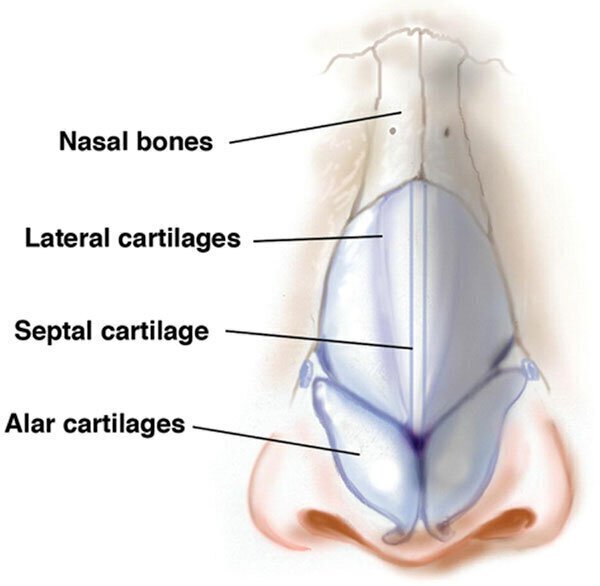
Dr. Durkin explains the structures of the nose and their importance in the function and anatomy of the nasal passages and why these structures are important during rhinoplasty surgery.
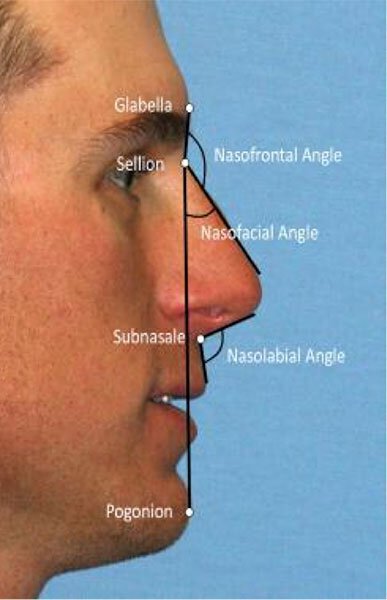
Picture shows the anatomy of the nose. Dr. Alan Durkin explains the different anatomical angles of the nose and face that when changed, alter the balance of the face.
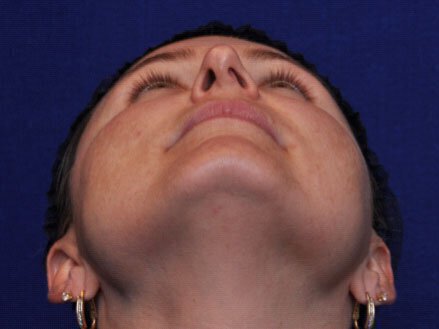
Patient had a deviated septum that resulted in sinus problems and difficulty breathing out of one nostril. Dr. Durkin is able to correct deviated septum's through surgical procedures.
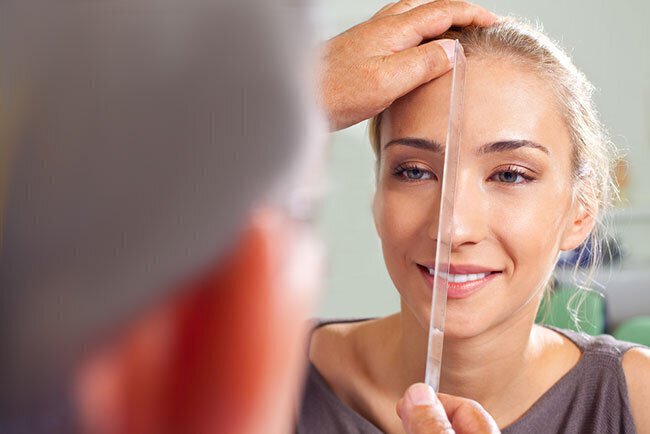
Dr. Durkin provides free cosmetic consultations for nose jobs. He performs both surgical and nonsurgical treatments for reshaping and reducing the nose.
Nose Aesthetics
—Dr. Alan Durkin, MD., Board Certified Plastic Surgeon
Secondly, the cartilage structure of you nose is crucial towards both functionality and appearance of your nose, especially in the lower vault, or nasal tip.
There are three cartilage components to the nose:
Furthermore, the shape and aesthetics of your nose are primarily defined by the size, position, and orientation of the nasal bones and the cartilaginous structures of the nose.
As such, any rhinoplasty procedure must be designed to improve positioning of the nasal bones and cartilages without removing their ability to support the nose. Maintaining support of the nose is absolutely critical to success in rhinoplasty. A balance during surgery must be struck between nasal beauty and nasal structure/support to create a beautiful and functional nose.
Lastly, your nose is evaluated by a number of fixed points and angles as shown in the figure below. There are three angles of critical importance: 1) Nasofacial angle, 2) Nasofrontal angle, and 3) the Nasolabial angle. As shown in the figure below, the size of each angle, and their relationships to each other define the overall aesthetic of the nose. During a rhinoplasty procedure, Dr. Durkin will strive to create as an ideal set of angles possible for your best possible result without compromising nasal function.
The last crucial analytic step in nasal analysis is how the nose relates to the face as a whole. The nose must be harmonious with the overall facial structure, especially from a profile standpoint. As such, the nasocervical angle, as shown below, must be evaluated and managed. Rhinoplasty will almost always impact the overall profile of the face, and its success can be minimized with an under-projected chin.
Because of this, an evaluation of the profile of the face must be undertaken during rhinoplasty analysis. It is very common to combine chin implantation with rhinoplasty in the context of an under-projected chin.
We believe in creating beauty by supporting the nasal structure rather than removing it or resecting it. With the exception of prominent nasal bumps, we try to create a more ideal and pleasing nose by adding to its support structure rather than by removing it.
This does not mean that we seek to increase the size of people’s noses. Quite the contrary, we seek to refine and improve your nose by repairing the natural anatomy present in every nose rather than removing it. We do not believe in resectional approaches to the upper and lower lateral cartilages. Moreover, we believe in re-positioning these critical structures into their ideal positions, and then reinforcing their new position with support techniques, such as cartilage grafting, allograft cartilage grafting, and suture techniques.
The only time that we stress a resectional approach is when patients present with large nasal humps. In these cases, we will resect the excess cartilage and bone present in the dorsum of the nose. However, in dealing with the middle and lower vaults of the nose, we are very conservative with resectional techniques, and we always attempt to improve nasal support rather than remove it. Read more about Dr. Durkin and his credentials.
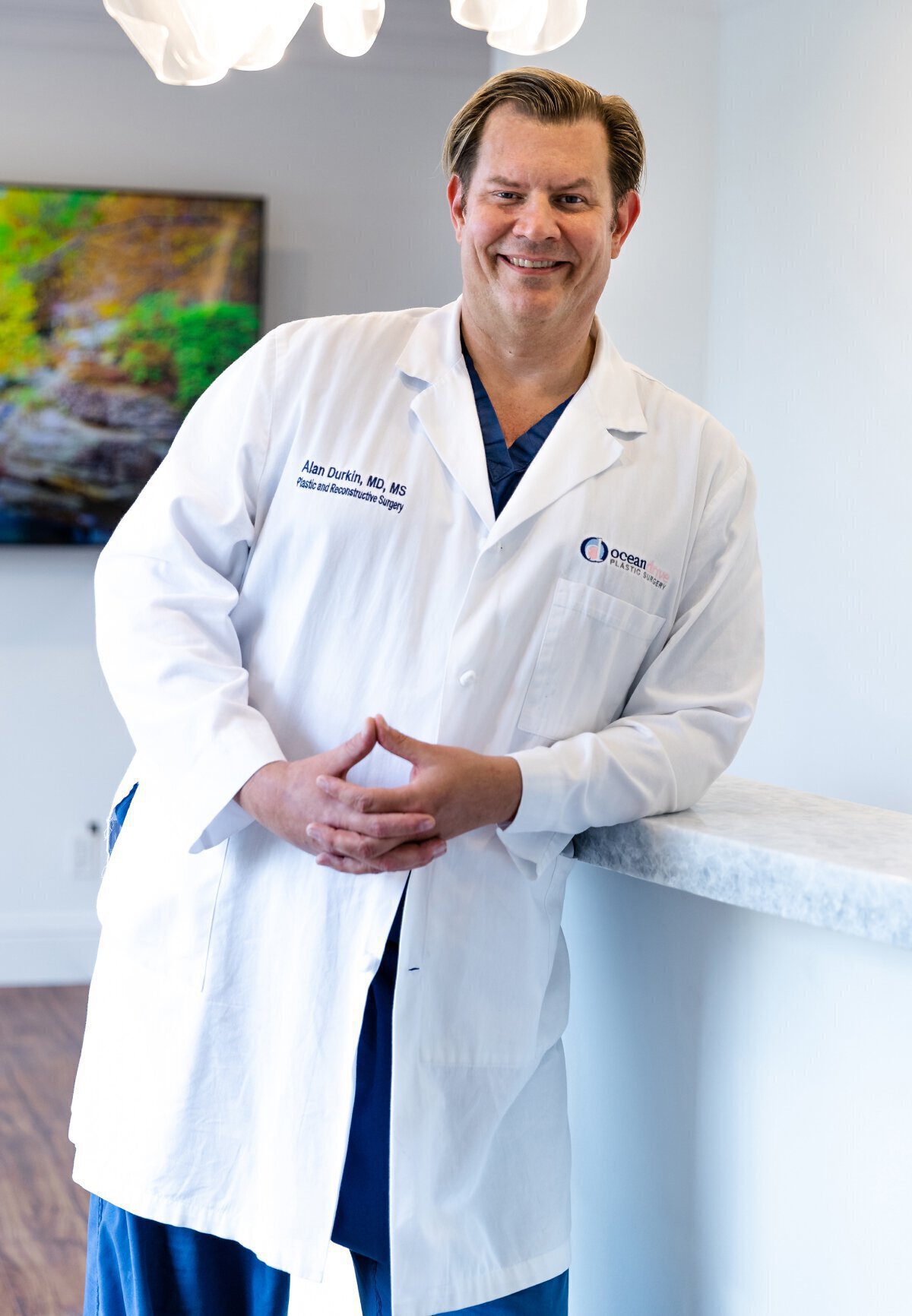
The procedure itself is undertaken under a light sedation anesthesia, and patients have zero memory of the surgery itself, and zero discomfort.
After surgery, patients will have more swelling and pressure than pain and discomfort. All patients are given pain medications following rhinoplasty, but most patients do not require the use of them. Pain is not a common complaint following this procedure. This depends on the magnitude of correction that is undertaken. Patients have minimal or no bruising if there is no need for nasal bone repositioning.
However, if the nasal bone has to be moved, patients can expect bruising in the lower eyelids for 5-8 days following surgery. Swelling to the nasal soft tissue can last up to 6 months, but the overwhelming majority of our patients look and feel good at 1-2 weeks. Your final result from Rhinoplasty surgery is seen 1 year following the procedure.
The short answer is no. Insurance providers can often fund a septoplasty procedure, which is designed to improve nasal airflow by removing a malpositioned piece of septal cartilage, but they will not pay for a cosmetic rhinoplasty procedure. We do not file Rhinoplasty to insurance carriers for coverage.

When you wake up from surgery, you will have a dressing on the outside of your nose. This dressing is removed on day 7 after surgery.
Sutures are removed day 7-9 depending on how the skin is healing. Patients are able to shower the day following surgery, and can start light exercise at 48 hours following surgery. Swelling to the nasal soft tissue can last up to 6 months, but the overwhelming majority of our patients look and feel good at 1-2 weeks. Your final result from Rhinoplasty surgery is seen 1 year following the procedure.
Patients most commonly return to work or school the day following suture removal, usually day 7-9. For patients who fly in for surgery, we request that you stay in the area for nine days postoperatively. We can accommodate for patients who want to fly out earlier, but require that we directly communicate with your physician at home to ensure appropriate timing of suture removal.
Absolutely. Most patients are discharged to home in the company of their loved ones 1-2 hours following the procedure. Patients are given their postoperative appointment schedules prior to surgery, and all medications are filled on premises prior to surgery. This allows patients to minimize their errands and responsibilities following their procedure, and ensures that their medications are correctly distributed?
Our beach side practice boasts an on-site, state certified operating room and recovery area, located conveniently in the Oakpoint Professional Building on A1a in Vero Beach.
Our operating room is dedicated to aesthetic surgery only, and it only serves Ocean Drive Plastic Surgery patients. All employees at Ocean Drive Plastic Surgery are employed full time, and are covered by the strictest levels of privacy, HIPAA compliance, and provide the finest customer service possible. For our friends to the north, ask about our Brevard county location at 833 E. New Haven Ave., Melbourne, FL 32901.

Because our surgery center only provides cosmetic surgery, we have refined and created our own deep twilight anesthetic technique at Ocean Drive Plastic Surgery.
The technique is more similar to a colonoscopy type anesthetic than a formal surgical anesthetic. Most patients receive rhinoplasty without a formal general anesthetic. Surgery is most often performed without any endotracheal tube placement, and the use of anesthetic gas, paralytics, and high dose narcotics is minimized. You can read more about our process for safe anesthesia.
Most patients complain more of discomfort from nasal and sinus congestion that from pain. Any pain should be controlled by the prescribed medication. After the first day the pain may subside enough so that plain Tylenol may be sufficient. If not, give us a call. Swelling and bruising about the eyes and cheeks is variable. Swelling maximizes at about 2 days, and then subsides over the next 5 to 6 days. Do not worry if you have excess swelling around the eyes and cheeks. This will clear completely and not adversely affect the result. Bruising (discoloration) may persist a few days longer. Remember, all of this subsides in time and has no bearing on the result. Under no circumstances should ASPIRIN, IBUPROFEN, or medications containing aspirin or salicylates or ibuprofen, be taken without first consulting us.
It is normal to have some bleeding for the first 12 hours after surgery. It may be necessary to change the gauze drip-pad a dozen or so times over that period. It is normal to have pinkish-reddish discharge from the nose and throat for the first 3-4 days. This will gradually subside. If you have any profuse nasal bleeding after this time, immediately lie down with your head elevated on 3 or 4 pillows. Iced washcloths over the eyes may help. Give us a call if these measures do not suffice. Avoid rubbing nostrils with a tissue.
Any sutures and nasal dressing are removed and the nose is cleansed 8 days after surgery. When the dressing is removed the nose will be quite swollen and the nasal tip will be turned up. This will settle down considerably over the next 3 to 4 days, then more gradually thereafter. Remember that the nose does not assume its final shape until many months after surgery depending upon the type of nasal skin you have. It will probably look better than prior to the operation within 2 to 3 weeks, but the final results take longer – be patient.
Infection is rare after rhinoplasty, but occasionally does occur. Fever over 100° F., excessive pain, and swelling with redness may signify a developing nasal infection and should be reported. Infections generally clear up quickly with appropriate antibiotic treatment.
Most patients complain more of discomfort from nasal and sinus congestion that from pain. Any pain should be controlled by the prescribed medication. After the first day the pain may subside enough so that plain Tylenol may be sufficient. If not, give us a call. Swelling and bruising about the eyes and cheeks is variable. Swelling maximizes at about 2 days, and then subsides over the next 5 to 6 days. Do not worry if you have excess swelling around the eyes and cheeks. This will clear completely and not adversely affect the result. Bruising (discoloration) may persist a few days longer. Remember, all of this subsides in time and has no bearing on the result. Under no circumstances should ASPIRIN, IBUPROFEN, or medications containing aspirin or salicylates or ibuprofen, be taken without first consulting us.
Every post-op patient will receive the following four meds which may be adjusted due to medication allergies etc.
Limit your activity over the first week following surgery. You are encouraged to walk about the house, but to avoid bending over at the waist or picking up heavy objects. If you over exert yourself, bleeding may result. When you rest or sleep, keep your head elevated on 2 or 3 pillows and try to avoid turning on your side. Restrict your diet to plenty of fluids and easily chewed foods. Hard to chew foods such as steak should be avoided for a week.
You may carefully clean about the nostrils with a cotton swab (e.g. Q-tip) and peroxide 3 times per day. Immediately afterward, place a bit of pure Vaseline or antibiotic ointment in the nostrils to keep them from drying out. Your nasal passages will be partially obstructed by swelling for at least two weeks. A humidifier may help you sleep by allowing you to breathe through your mouth more comfortably.
Do not blow your nose or sniff excessively as this will only irritate the healing tissues. If you must sneeze, open your mouth. Also, avoid picking up babies or small children; a flailing little arm may strike your nose. You probably will hit your nose at least once during the first week. This will hurt but cause no problem unless the force is excessive.
You may bathe in the tub; avoid showering, as you must keep the nasal dressing dry. It is all right to carefully wash your face with a mild soap and a clean washcloth.
It takes about six weeks for the nasal bones to fully heal. Slowly resume your activity. After the first week, let your body tell you how much to do. Strenuous exercise may be resumed in 4 weeks. Build up to this level slowly. Semi-contact sports are to be avoided for 4 to 6 months. Full swimming is allowed after 4 weeks. Do not let your nose become sunburned. This may result in prolonged swelling and redness.
Avoid cigarette smoking or even being in an area of excessive smoke as this irritates the nasal tissues and impedes healing. Also avoid alcoholic beverages the first week following surgery as this may increase your chances of bleeding. Under no circumstances should ASPIRIN, IBUPROFEN, or medications containing aspirin or salicylates or ibuprofen, be taken without first consulting us.
If you have any questions or concerns, please do not hesitate to contact the office at (772) 234-3700. If you have an emergency after regular office hours, please call 911 or go to your local emergency room.
If you're looking for alternatives to surgery for your treatment? Ocean Drive MedSpa has the perfect non-surgical solution for you. Our expert team offers non-surgical face treatments that can help you achieve a more youthful and refreshed appearance without the need for surgery. Our state-of-the-art techniques and technologies are designed to lift and tighten the skin, giving you a more youthful and radiant look. Plus, with our minimally-invasive approach, you can enjoy quick and easy recovery with no down time. Explore our website to learn more about our non-surgical face treatments and schedule a consultation today to take the first step towards a more youthful you.
Visit Ocean Drive MedSpa

At Ocean Drive Plastic Surgery in Vero Beach, Dr. Alan Durkin and their team of providers deliver incredible results tailored to your needs in a relaxing and uplifting atmosphere. Learn more about the Ocean Drive difference by scheduling your one-on-one diagnostic consultation with Dr. Durkin today.